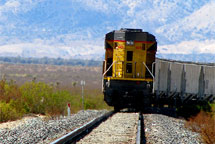 |
 |
|
| eNews • November 2010 | ||
| Promoting a Cost-Effective, Reliable and Competitive Transportation System |
||
 Ag Shippers Comment on Harvest Rail Service
Ag Shippers Comment on Harvest Rail Service
The Soy Transportation Coalition (STC) recently contacted a number of mid to large-sized agricultural shippers across the country to ask how the rail industry performed in handling the 2010 harvest. The STC specifically wanted to hear comments from shippers - positive or negative - concerning service reliability and rail capacity issues.
Given the large and compressed harvest as well as the increased world demand for U.S. wheat due to Russia's export ban, the U.S. freight rail infrastructure has been tasked with a sizable challenge.
“Farmers and agricultural shippers certainly understand there are logistical challenges with absorbing such a sizable and concentrated harvest,” explains Mike Steenhoek, executive director of the Soy Transportation Coalition. “However, the feedback from this fall suggests that certain railroads - particularly BNSF and Union Pacific - have been more strategic in planning and more prudent in investing than others. Testimonials from agricultural shippers validate that the harvest surge, while producing temporary congestion, does not have to result in system paralysis if railroads are adequately prepared.”
Below are some verbatim comments received from agricultural shippers. While not a scientific survey, the below comments represent the perspectives of those who ship millions of bushels of grain and oilseeds. Both positive and negative comments were received. Shipper comments on the 2010 harvest:
- "Cars for processors are extremely tight. Some congestion at the Gulf and trains are backed up for grains."
- "Overall, harvest has been going well. Railroad service has been up and down. Still lots of car delays and shortages of equipment and service causing problems moving product..."
- "I would say that our infrastructure has held up pretty well in light of the compressed harvest. It really has been a tale of two regions this harvest as far as rail service. The Norfolk Southern Railway (NS) has failed miserably this fall...CSX is somewhat better than the NS, but is still a far cry from being fluid...The western carriers are performing pretty well. In fact, the BNSF's velocity has picked up since September...The UP has been a little late on getting equipment placed, but seems to be holding up pretty well."
- "In the west, supply and service have been excellent...NS car supply has been a struggle and their service has been a challenge from time to time. Think we are over the worst."
- "NS is in meltdown...Other railroads are dealing with the normal capacity issues...NS is the problem."
- "Harvest is going well, for the circumstances...We are experiencing some delays, however it is not that bad...I have a hard time calling (occasional delays) a railroad/infrastructure problem...To build the infrastructure to handle the crop in 7 to 10 days would be costly and the U.S. farmer would run the risk of not being competitive with the extra costs."
- "We're pretty well harvested with no major backups."
- "Some start up problems, but overall it's been a relative non event...Some elevators were plugged, but it only lasted a brief time."
- "We're seeing capacity constraints with rail. If I had to rank service this season for our three major rail carriers I would say: UP is best, BNSF second, CP third."
- "Harvest is going relatively smoothly. Cars are tight, but you can't build a church for Easter Sunday."
- "Grim performance by both eastern Class I's: insufficient crews, insufficient or out of position power...Class I's continue to saddle us with higher (double-digit percent increases) rates despite insulation from fuel. Service is poor to very poor. Accessorial charges are another means to revenue."
This past spring, the Soy Transportation Coalition published its first annual Rail Customer Satisfaction Index. BNSF Railway and Union Pacific Railroad ranked first and second respectively by shippers of agricultural products. More information about the index can be accessed at: http://soytransportation.org/newsroom/stc042310railcustomersatisfaction.pdf.
Soy Transportation Coalition |
|
